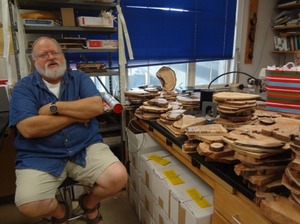By Ari Phillips
On the Road with Ari Phillips: Energy and Climate Change in the American Southwest
I meet Tom Swetnam, director of the laboratory of tree-ring research at the University of Arizona in Tucson, on a Sunday morning because he’s leaving for Siberia in a few days and is otherwise totally booked. As part of the paleofire team that will be traveling to the “Alaska of Siberia, if you will” to study fire and climate, Swetnam will spend a few weeks immersed in the burn history — and possible future — of some of the largest forests on Earth.

“We’re trying to understand fire, climate change, and carbon emissions out of Siberia because of the huge carbon pool contained there in the soil, permafrost, bogs, and forests,” says Swetnam, a sturdy middle-aged man with an outdoorsy white beard. “This giant pool of carbon is beginning to burn in a massive way — the amount of area burning in Siberia is startling.”
Here in the Southwest, the same could be said. Already this year fires have scorched unprecedented swaths of New Mexico and Colorado, and although Arizona is yet to feel anything approaching last year’s record-breaking blazes, the hiatus offers little more than a breath of fresh air.
Of course Swetnam knows all this and much more. As an expert in dendrochronology, or tree-ring dating, he’s been determining historical drought, climate and fire patterns as revealed by forests across the Southwest and beyond for upwards of 30 years. Dendrochronology, said to be the only science native to the Southwest, originally gained widespread attention in the early 20th century as a way to date ruins from lost cultures in the region, such as those found at Chaco Canyon and Mesa Verde.
Swetnam runs through the fire history of the West like it’s his usual Sunday sermon. Dry years have traditionally led directly into large burn years. Fire patterns tend to correlate with precipitation patterns in the region such as those associated with El Niño and La Niña. Climate change is likely intensifying weather extremes and causing hotter and drier weather, both exacerbating fire danger.
Then he gets into the less established theories.
“It’s not just the drying and not just high temperatures that are increasing burns, but the extraordinary wind events happening as well,” says Swetnam. “It’s possible that this is associated with weather pattern changes. Kind of like massive cold fronts, with lightning.”
Or if not wind, maybe snow.
“It might be that for the high elevation and mountain areas snowpack is very important. This summer for instance we’ve seen burning in those wetter, higher forests in Colorado and New Mexico after multiple years of drought and little snowpack.”
Swetnam sees this as a very important question: When is it going to start burning at higher elevations where spruce and mixed-conifer thrive? Since 2000 there’s been a number of big fires in the Southwest, but mostly down in the middle and lower elevations. Looking back, 2012 may provide the answer.
“This year was classic in showing the connection between temperature increases and early snowmelt,” says Swetnam. “When we get an extended spring the snows leave early, so by true summertime the higher elevations are ready to burn.”
There’s also the issue of devastating re-burns, and not just at higher elevations. Take the Las Conchas Fire in the Northern New Mexico Jemez Mountains last year that re-burned over areas hit by the Cerro Grande Fire in 2000 and the Dome Fire in 1994.
Swetnam estimates that the first time the forest burns it loses 30 to 40 percent of the overstory, or uppermost layer of forest canopy, because the landscape has a lot of understory fuel and dense thicket stands — often even denser than they should be due to the recent history of fire suppression by the Forest Service — thus leaving behind a patchy mosaic of burn scars.
“A lot of burned areas come back as shrubs, Gambel oak, or grasses at first,” says Swetnam. “If another catastrophic fire blows through you’re left with enormous canopy holes. It could be thousands of years before forest is able to grow back due to lack of seed source and extreme erosion.”
At higher elevations Aspen — slender, deciduous trees that spread through a connected root system and grow in dense groves — might make all the difference in regenerating higher elevation forests because of their ability to grow back after a fire and stimulate groundcover. “Unless we get 2, 4, or 6 degrees C of warming,” says Swetnam. “Then all bets are off.”
A former Forest Service firefighter himself, Swetnam seems well suited for the outdoors but has adjusted to life in the cavernous corridors of the U of A football stadium, where the tree-ring lab is located until their new building is completed within the year. By the time he joined the Forest Service in the mid-’70s the Gila Mountains in Western New Mexico were one of the first places to reintroduce controlled burns after decades of total fire suppression.
For Swetnam monitoring these fires was a major eye opener.
“We were out there for over a month just walking and riding horses around the fire,” recalls Swetnam. “Rather than just thinking about putting the damn thing out, I had the chance to wander around the low, creeping flames and smoke and just watch. It was a beautiful revelation about how things are supposed to be.”
(Editor’s Note: This article was originally published in Grist.)
Ari Phillips is a graduate student at the University of Texas at Austin pursuing a dual degree in journalism and policy studies with a specialization in energy, environment, and technology. He has published in GOOD, NYT Dot Earth, Think Progress, and others. Follow him on Twitter @re_ari.




